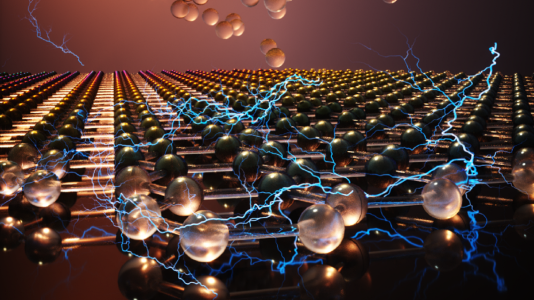The materials used to power electronics must also get thinner as they get smaller and smaller. In light of this, finding materials that can keep unique electrical properties at an ultrathin size is one of the fundamental difficulties researchers confront when creating the next generation of energy-efficient devices.

A representation of a two-dimensional ferroelectric material. Image Credit: UC Berkeley/Suraj Cheema
Ferroelectrics, a class of advanced materials, offer a promising way to reduce the power used by the ultrasmall electronic parts found in computers and cell phones. Ferroelectrics are a family of materials in which some of the atoms are positioned off-center, resulting in a spontaneous internal electric charge or polarization.
They are the electrical counterpart to ferromagnets. When the material is exposed to an external voltage, its internal polarization might change direction. The potential for ultralow-power microelectronics is enormous.
Unfortunately, below a few nanometers in thickness, ordinary ferroelectric materials lose their internal polarization. This indicates that they are incompatible with the silicon technology used currently. Ferroelectrics had hitherto been unable to be integrated into microelectronics due to this problem.
However, a group of scientists from the University of California, Berkeley, are currently conducting tests in the US.
The Department of Energy’s (DOE) Argonne National Laboratory has developed the thinnest ferroelectric ever recorded and the thinnest demonstration of working memory on silicon to solve both issues at once.
The research team found stable ferroelectricity in an incredibly thin layer of zirconium dioxide that was only half a-nanometer thick in a study that was published in the journal Science.
It is approximately 200,000 times smaller than human hair and is equivalent to the size of an atomic building block. This material was developed by the team directly on silicon. The researchers discovered that when zirconium dioxide, a normally non-ferroelectric material, is grown to a thickness of just 1–2 nm, ferroelectricity begins to develop.
Notably, the ferroelectric behavior persists up to its approximate half-nanometer thickness limit, which is close to the atomic scale. The thinnest ferroelectric has ever been created due to this fundamental discovery. This is unexpected for a material that is not even frequently ferroelectric in bulk form.
The thinnest working memory demonstration ever recorded on silicon was made possible by the researchers’ ability to alter the polarization of this ultrathin material back and forth with a minimal voltage. Additionally, it has great promise for energy-efficient electronics, especially in light of the fact that modern silicon chips already contain ordinary zirconium dioxide.
This work takes a key step towards integrating ferroelectrics into highly scaled microelectronics.
Suraj Cheema, Study First Author and Postdoctoral Researcher, University of California, Berkeley
The Advanced Photon Source at Argonne, a DOE Office of Science user facility, was essential to visualize the ferroelectric behavior of such ultrathin structures.
X-ray diffraction gives needed insight into how this ferroelectricity emerges.
John Freeland, Study Author and Physicist, Argonne National Laboratory
This discovery has important implications for creating new two-dimensional materials in addition to its immediate technological significance.
Cheema stated, “Simply squeezing 3D materials to their 2D thickness limit offers a straightforward-yet-effective route to unlocking hidden phenomena in a wide variety of simple materials. This greatly expands the materials design space for next-generation electronics to include materials already compatible with silicon technologies.”
As Cheema pointed out, the potential for a new class of 2D materials—atomically thin 3D materials—that go beyond ordinary sheets of 2D materials like graphene can be obtained by merely developing a few atomic layers of a 3D material.
The authors of this study anticipate that it will spur further investigation into two-dimensional 3D materials showing emerging electrical phenomena pertinent to energy-efficient devices.
Cheema and Sayeef Salahuddin of UC Berkeley, along with co-first authors Nirmaan Shanker and Shang-Lin Hsu, led this study.
The researchers used synchrotron X-ray absorption spectroscopy and X-ray diffraction at beamline 33-BM-C of Argonne’s Advanced Photon Source, in collaboration with Argonne physicists Freeland and Zhan Zhang, to examine the structural evolution of ferroelectricity to the atomic scale and uncover its electronic origins.
Soft X-rays and transmission electron microscopy were used at the DOE’s Lawrence Berkeley National Laboratory’s Advanced Light Source and Molecular Foundry to examine the ferroelectric crystal structure of the material.
Journal Reference:
Cheema, S. S., et al. (2022) Emergent ferroelectricity in subnanometer binary oxide films on silicon. Science. doi:10.1126/science.abm8642